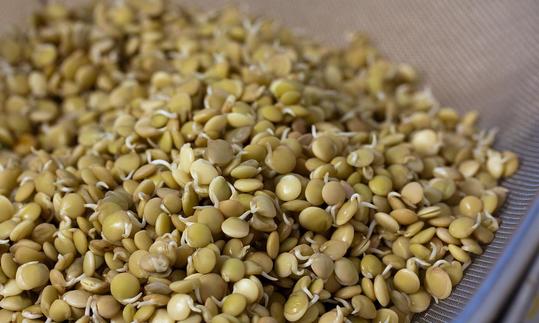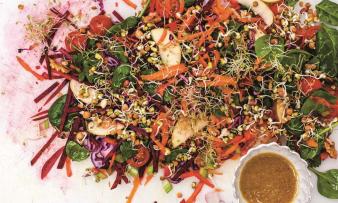Table of contents
Sprouted lentils ( Lens culinaris ) can be eaten raw in a salad (raw food) or cooked. The sprouts contain significantly more vitamins and minerals than dried lentils. Sprouts are different from sprouts. Organic lentils are usually better suited for production.
Use in the kitchen
Lentils are indigestible in their raw form because they contain toxic ingredients (eg lectins) that can be rendered harmless by cooking. Soaking for a long time, germinating or cooking reduces harmful substances sufficiently. Germinated lentils can therefore be eaten raw.
Should you cook sprouted lentils? Sprouted lentils should not be cooked as this will cause valuable ingredients to be lost.
Eating lentil sprouts raw: Sprouted lentils have a wonderful sweet, nutty taste and are ideal as a salad base or for garnishing. Pureed and refined with herbs, you can conjure up a vegan spread. Sprouted lentils taste more like vegetables than protein. Steamed or blanched, they develop a delicious aroma. However, they lose valuable ingredients due to the heat and are therefore less healthy. Sprouted lentils go well as a topping for stews such as vegetable curry, risotto or soups (e.g. curry butternut squash soup with sprouts or radish leaf and spinach soup with pumpkin seed topping ).
Germinate lentils
If you want to germinate lentils yourself, you need unpeeled, raw lentils, preferably organic.
Can red lentils germinate? Red and yellow lentils from the supermarket are almost always peeled and therefore no longer germinate. There are also unpeeled yellow and red lentils; however, the seed coat of red lentils is generally darker in color (depending on the country of origin) and is therefore also often referred to as brown or black lentils. 14,15 Organic seeds do not normally contain any germination inhibitors. You can do a germination test before the process by placing just a tablespoon of lentils on a damp kitchen towel. Make sure that the kitchen towel is always damp for the next few days. If the lentil seeds are OK, the germs should be visible after 3 - 10 days. It is also important how many of the seeds germinate - if less than half germinate, the lentils are not suitable for making germinated lentils.
You will need a propagation device, such as a germination jar, a bowl or a sprouting jar. To start with, a clean screw-top jar with a perforated lid is sufficient for germination.
During the germination process, you should always keep an eye on the cleanliness! Since the seedlings are very susceptible to mold, it is advisable to boil the jar first. The seeds must also be clean. Rinse the lentils thoroughly with water over a sieve. So that the seeds can start the germination process better, you should soak the lentils in water for 1-2 hours. This is not absolutely necessary for unpeeled red lentils. After soaking, rinse the lentils well. To do this, pour away the soaking water, fill with fresh water and then pour it off again. Regular rinsing is also necessary during the germination phase. Rinsing twice a day with fresh water is sufficient - except in summer: then 3 rinses per day are recommended. 10
Lentils (like most large seeds) germinate in the dark. Contrary to advice to the contrary on various websites, we do not recommend a bright location. In addition, waterlogging must not occur, which is why the jars should be placed at an angle with the opening facing downwards. The lentil seedlings form after about 1-2 days. If you leave them in the jar for longer, a maximum of 3 to 4 days, sprouts will develop that can be eaten raw. Larger lentils such as plate lentils (6-7 mm) or giant lentils require a longer germination period (see phytic acid or phytate and soaking or germination ). Before eating, rinse the germinated lentils or sprouts well one last time (depending on the germination time).
Vegan raw food recipe for sprouted lentil salad
Ingredients (as a side dish for 3 people): For the refreshing salad you need 250 g sprouted lentils (raw, organic), 2 chopped shallots, 100 g dried tomatoes in thin strips, approx. 125 g sliced celery, 1 finely chopped garlic clove, a little olive or rapeseed oil * and (depending on taste) 2 tablespoons or more apple cider vinegar, salt ,pepper, parsley
Preparation: Put the sprouted lentils and vegetables in a bowl, mix the oil and vinegar and stir in. Season with a little salt, pepper and chopped parsley.
* Rapeseed oil is healthier than olive oil . For a healthy diet (based on raw or cooked food), it is recommended to use oil sparingly or even to avoid it altogether.
Vegan recipes with sprouted lentils can be found under the note: " Recipes that have the most of this ingredient ".
| Not only vegans or vegetarians should read this: Vegans often eat unhealthily. Avoidable nutritional errors . |
Purchasing - Storage
It is best to buy germinated lentils in well-stocked organic shops. Occasionally you can also find them in the refrigerated section of the usual supermarket chains such as Coop, Migros, Denner, Volg, Spar, Aldi, Lidl, Rewe, Edeka, Hofer, Billa etc. as raw food. You can often get them online via priority delivery. If possible, go for organic quality, from domestic or even local production.
You should also look out for mold in purchased products. However, the furry, fluffy fibrous roots are often confused with mold. A smell test will help you distinguish mold from the fine roots: mold smells musty, fibrous roots smell more fresh to strongly sharp.
There is a significant difference between seeds (1), germs and sprouts: Lentil sprouts (2) are only one to a few millimeters long and you eat the seeds and roots. Lentil sprouts (3) however, they reach a few centimeters: Lentil sprouts are also edible raw. As sprout greens (4) they then form cotyledons. In this case, the seed is cut away.
The availability of sprouted lentils varies depending on the size of the store, catchment area, etc. Our recorded food prices for the DA-CH countries can be found above under the ingredient image - and by clicking you can see their development at various suppliers.
Storage tips
Germinated lentils should be kept in the fridge and eaten within 3 days. If you store them for longer, they will continue to grow in the fridge, but they will lose valuable vitamins and trace elements - or go bad. Home-germinated lentils can be eaten raw straight away or put in a sealable jar or bowl, refrigerated and consumed within two days.
Ingredients - Nutritional values - Calories
The nutrients in sprouted lentils are better absorbed. They contain more protein, fiber and vitamins than dried lentils . 5 Eating sprouted lentils does not mean that you consume more minerals such as iron, sodium, potassium, calcium, magnesium, phosphorus and zinc than with unsprouted lentils. Sprouted lentils are heavier than dried lentils because they swell before sprouting. This makes a one-to-one comparison of the nutrients difficult.
But sprouted lentils contain significantly more vitamin E and B vitamins (including thiamine, niacin and folic acid ). 5 Lentil sprouts, eaten raw, contain a considerable amount of vitamin C (16.5 mg/100g). 4 This is roughly equivalent to the content of pineapple, orange tomatoes or persimmons . Guava (228.3 mg) and yellow bell peppers (183.5 mg) contain significantly more vitamin C. 13
Sprouted lentils provide 106 kcal/100g. The macronutrients are contained in the following amounts: fat is 0.55 g/100g (mainly unsaturated fats), carbohydrates are 22 g/100g and protein is 9.0 g/100g. 13
The most important micronutrient in sprouted lentils is folic acid ; 100 g contain 100 µg of folic acid – 50% of the daily requirement. Almost twice as much folic acid is found in raw spinach (194 µg/100g) or seaweed, such as wakame with 196 µg/100g. 13
Lysine, an essential amino acid, is contained at 0.71 g/100g, comparable to edamame . This is a considerable amount (38% of the daily requirement). Other legumes such as chickpeas (1.4 g/100g) or black beans (1.5 g/100g) are even better sources of lysine. 13
Another essential amino acid is found in germinated lentils: threonine with 0.33 g/100g. Similar amounts are found in green spelt, for example. Much more can be obtained from tempeh (0.80 g/100g) or goa beans (1.2 g/100g). 13
During the germination process, up to 80% of difficult-to-digest complex carbohydrates (triple sugars or trisaccharides) are converted into easily digestible disaccharides. 3
In germinated legumes, the content of the essential amino acid methionine and the conditionally essential amino acid cysteine increases.
The complete ingredients of sprouted lentils (including kcal), the coverage of the daily requirement and comparison values with other ingredients can be found in our nutrient tables. In the article Nutrients explained you will get a detailed insight into the topic.
Health Benefits
Lentils are high in protein, low in calories and contain many essential nutrients. Compared to other legumes, lentils have less of the unpleasant phytic acid. Lentils are also high in phenols (see next section). Sprouted lentils offer some health benefits over raw lentils because the sprouting process improves the chemical composition. 20
In addition to their nutritional value, lentils offer a variety of potential health benefits: reducing cholesterol, helping to treat blood sugar disorders, lowering blood lipids and reducing the risk of cardiovascular disease and cancer. 21
Lentils are a good source of iron (8 mg/100g) and are therefore considered effective against anemia. Due to their high fiber content, they help with constipation and lower cholesterol levels. They cause blood sugar to rise slowly and are therefore also recommended for diabetics. The high folic acid content is particularly beneficial for women who want to have children and pregnant women. 6
The phytic acid it contains is said to have an antioxidant and anti-carcinogenic effect. The reduced risk of colon cancer is due to the chelation with iron. Phytic acid has a positive effect on prostate cancer, breast cancer and pancreatic cancer and is also said to lower blood sugar. 1,2
All in all, lentils are an excellent source of fiber, nutrients and antioxidants. Due to their protein content, lentils are an ideal health-promoting ingredient, particularly for vegetarians and vegans, with few calories and a low glycemic index. 25
Secondary plant substances
Many of the health effects of germinated lentils can be attributed to the secondary plant substances they contain. Our article on secondary plant substances provides an overview of the classification of substance groups, their occurrence in foods and possible effects on humans. Germinated lentils contain the following secondary plant substances, among others: quinic acid, tocopherol, catechin and epicatechin. 21,25
However, it should be noted that the composition of secondary plant substances in germinated lentils can vary depending on the variety, time of harvest and growing conditions. 21 Therefore, quantities are only of limited use and should only be understood roughly.
Dangers - Intolerances - Side effects
Can you eat lentils raw? Raw lentils, like other legumes, have a high phytic acid content. Phytic acid is found inside the endosperm. Phytic acid is very important for the germ, but less so for us humans. Lentils should not be eaten raw, but eating germinated lentils raw is common.
Phytic acid binds minerals and trace elements such as calcium, zinc, iron, magnesium and manganese. Phytic acid also inhibits certain digestive enzymes, but also has positive effects. For more information, see the article: Phytic acid or phytate and soaking or sprouting .
If you eat raw lentils without germinating them, you will suffer from headaches, vomiting, diarrhea, or stomach and intestinal problems. The germination process breaks down various substances in raw lentils that are unhealthy or poisonous. Among other things, it breaks down the tannins contained in the raw seeds. 12 Tannins are anti-nutritional substances that can render other nutrients completely or partially unusable. In addition, the hemagglutinin content of the lentils is reduced when they germinate. These lentil lectins can cause red blood cells to clump together if unsprouted lentils are consumed in excess and are therefore considered toxic. The germination process is said to reduce the hemagglutinins by 75-100%, although there are also studies that show less. 11 Soaking already leads to a reduced tannin and lectin content.
Mold infestation on sprouts is relatively common. You should always make sure that the rinsing water can drain properly and that no water accumulates. If mold appears, please remove everything and then clean the work surface, containers and your hands thoroughly.
Despite their reputation as a healthy food, outbreaks of disease have occurred in recent years due to the consumption of pulses. These outbreaks were associated with the consumption of seeds and raw sprouts. These seeds and sprouts were often contaminated with bacteria such as Escherichia coli, Salmonella spp. and sometimes Listeria monocytogenes. In 2011, for example, Germany experienced an E. coli outbreak caused by contaminated seeds from Egypt. A similar outbreak occurred in Canada in 2005, when 600 people became ill after eating contaminated sprouts. These cases show that seeds and sprouts can be contaminated, as was also shown by a study from Latvia, in which various bacteria were found in microgreens and sprouts. 20 It is therefore particularly important to wash sprouts and germinated seeds well before consumption and to pay good attention to hygiene during processing.
Sprouted lentils and hydrogen cyanide
Sometimes you can find information on hydrogen cyanide and sprouted lentils on the Internet, often the terms B 17 as "vitamin", laetrile or amygdalin appear. Here we explain what it's really all about.
Amygdalin is a cyanogenic glycoside, i.e. a compound between an alcohol and a sugar, which is broken down by the body's own enzymes to produce hydrogen cyanide (HCN) or hydrogen cyanide. This ingredient can be found in a variety of other foods in addition to sprouted lentils. 16
The term "B vitamin 17 " is a synonym for the acronym laetrile or amygdalin - but this is a pseudovitamin that the body does not need for its normal function. There are also rumors dating back to the 1980s that this ingredient has anti-cancer properties. However, this claim was clearly refuted by a systematic review by a Cochrane Review in 2015. The study concluded that there is no reliable evidence for the alleged effects of laetrile or amygdalin on curative (healing) effects in cancer patients. 17
The best-known representative is the eponymous bitter almond, because amygdalin comes from the Latin 'amygdala' (ancient Greek ἀμυγδάλη) for almond kernel. However, even though hydrogen cyanide is a toxic component that can accumulate over time, the amounts contained in germinated lentils are not a cause for concern, unlike in bitter almonds.
Unfortunately, we were unable to find any well-founded studies on this, except for bitter almonds, which in turn speaks for the safety of the lentils. In addition, sprouting is definitely worthwhile, as it increases digestibility and reduces the content of resistant starch and anti-nutritional compounds. 18 The greatest danger is not the accumulation of hydrogen cyanide, but possible contamination by various bacteria. 19 However, this happens very rarely and can easily be avoided by good hygiene conditions.
Ecological footprint - animal welfare
Dried lentils (organic) have a CO 2 footprint of around 1.7 kg CO 2 eq/kg. That is relatively high for a plant-based food. 22 However, if you compare lentils to their nutritional value, they are indeed a climate-friendly ingredient. 28
The global average water footprint of lentils is 5874 l/kg. At first glance, this seems to be a very large footprint; vegetables have an average of just 322 l/kg. If you take the nutritional value into account, a different picture emerges: pulses need an average of 4055 l/kg, but only 1.19 l/kcal . In comparison, vegetables need 1.34 l/kcal. 23 Eggs have a footprint twice as large per kcal, and beef has ten times as much. 24
Despite extensive research, we were unable to find exact figures specifically for germinated lentils.
For detailed explanations of various sustainability indicators (such as ecological footprint, CO2 footprint, water footprint), see our article: What does the ecological footprint mean?
Animal welfare - species protection
Overall, the production of lentils has a positive effect on wildlife, as lentils are a good substitute for animal products and thus reduce animal suffering. Nevertheless, agricultural aspects such as the use of pesticides and changes to natural habitats can have a negative impact on biodiversity.
Lentils are susceptible to various pests and are therefore predestined for the use of pesticides. However, organic farmers use various strategies, such as crop rotation, mixed cropping and other natural methods, to keep these in check. 26 Such ecological principles play an important role in protecting biodiversity. 27
Worldwide occurrence - cultivation
The lentil as we eat it today probably originates from the wild lentil Lens orientalis from Asia Minor. Lentils have been planted and cultivated since the Neolithic period. They are one of the oldest types of dried vegetables. 7 In the Neolithic period (approx. 7000 BC), lentils were a major crop in the Fertile Crescent (Bulgaria, Greece). Lentils were also a staple food in ancient Egypt and Palestine.
Today, the main growing areas are Spain, Russia, Chile, Argentina, the USA, Canada and the Middle East. In India alone, over 50 types of lentils are grown.
Cultivation - Harvest
Lentils are legumes that bind nitrogen from the air with the help of nodule bacteria in the soil, which has a very positive effect on the soil. If other legumes were previously in the field, no inoculation with nodule bacteria is necessary. In addition, lentils are very undemanding and can also be grown on marly, sandy, calcareous, loose clay soils, which can also be quite shallow. They are considered to be weak competitors, which is why weed control in a pure culture is crucial for successful lentil cultivation. Depending on the climate and soil, there are also mixed cultures with oats or barley. Here it is important not to shade the lentils. Lentil cultivation in Europe is still a niche product and is more common in organic farming. 8
Lentils are harvested with a combine harvester, but it is difficult to determine the time of harvest because lentils ripen very irregularly (from bottom to top). Therefore, drying the harvested lentils is almost always necessary.
Further information
The lentil ( Lens culinaris ) is a plant species from the genus Lens, from the subfamily Faboideae, within the family Fabaceae or Leguminosae. 9
The seeds of all plants whose leaves, stems and fruits are edible are suitable for germination. Nightshade plants (potatoes and tomatoes) are not suitable because of the toxic ingredient solanine. Germinated garden beans can only be enjoyed after a 15-minute heating phase because of the phasin they contain. 4
Alternative names
The lentil is also called lentil nerve, erve or kitchen lens.
Bibliography - 28 Sources (Link to the evidence)
| 1. | Verghese M et al. Anticarcinogenic effect of phytic acid (Ip6): Apoptosis as a possible mechanism of action. LWT - Food Science and Technology. 2006;39(10):1093-1098. |
| 2. | Somasundar Pet al. Inositol hexaphosphate (Ip6): a novel treatment for pancreatic cancer. J Surg Res. 2005;126(2):199-203. |
| 3. | lebensmittellexikon.de Sprossen, Keimlinge, Sprossengemüse. |
| 4. | Krebs A. Die Kraft der Keimlinge. Oliv. 2010;3. |
| 5. | Davila MA, Sangronis E, Granito M. Leguminosas germinadas o fermentadas: alimentos o ingredientes de alimentos funcionales. [Germinated or fermented legumes: food or ingredients of functional food]. Arch Latinoam Nutr. 2003;53(4):348-354. |
| 6. | Pamplona Roger JD, Pamplona Roger JD. Heilkräfte der Nahrung: ein Praxishandbuch. 4. Aufl. in Dt., 35.-44. Tsd. Advent-Verl; 2012. |
| 7. | Delaveau P et al. Geheimnisse und Heilkräfte der Pflanzen. Zürich: Das Beste. 1978. |
| 8. | bioaktuell.ch. Anbau von Biolinsen: Erfahrungen in der Schweiz. 2018. |
| 9. | Yadava DK et al. Fundamentals of Field Crop Breeding [E-Book]. Springer Nature; 2022:1183. |
| 10. | Rohkost24. Keimen im Glas: Ausführliche Anleitung für kleine bis grosse Saaten. |
| 11. | Davis B, Melina V. Becoming Raw: The Essential Guide to Raw Vegan Diets. Book Publishing Company; 2011. |
| 12. | Nkhata SG et al. Fermentation and germination improve nutritional value of cereals and legumes through activation of endogenous enzymes. Food Science & Nutrition. 2018;6(8):2446-2458. |
| 13. | USDA. United States Department of Agriculture. |
| 14. | Yadav S., McNeil D. et al. Lentil: An Ancient Crop for Modern Times. Berlin: Springer Science & Business Media. 2007: 96-97; 384. |
| 15. | Samaranayaka A., Lentil. In: Nadathur S.R., Wanasundara J. et al. Sustainable Protein Sources, Elsevier. 2016. |
| 16. | Mondal S. Laetrile (Amygdalin or Vitamin B 17). Published online 2018. |
| 17. | Milazzo S, Horneber M, Ernst E. Laetrile treatment for cancer. Cochrane Gynaecological, Neuro-oncology and Orphan Cancer Group, ed. Cochrane Database of Systematic Reviews. 2015;2018(7). |
| 18. | S. Santos C et al. The effect of sprouting in lentil (Lens culinaris) nutritional and microbiological profile. Foods. 2020;9(4):400. |
| 19. | Kintz E et al. Outbreaks of shiga toxin–producing escherichia coli linked to sprouted seeds, salad, and leafy greens: a systematic review. Journal of Food Protection. 2019;82(11):1950-1958. |
| 20. | S. Santos C, Silva B et al. The effect of sprouting in lentil (Lens culinaris) nutritional and microbiological profile. Foods. 2020;9(4):400. |
| 21. | Xu B, Chang SKC. Phenolic Substance Characterization and Chemical and Cell-Based Antioxidant Activities of 11 Lentils Grown in the Northern United States. J Agric Food Chem. 2010;58(3):1509–1517. |
| 22. | Reinhardt G, Gärtner S, Wagner T. Ökologische Fussabdrücke von Lebensmitteln und Gerichten in Deutschland. IFEU Institut für Energie - und Umweltforschung Heidelberg. 2020. |
| 23. | Mekonnen MM, Hoekstra AY. The green, blue and grey water footprint of crops and derived crop products. Hydrol Earth Syst Sci. 2011;15(5):1577–1600. |
| 24. | Mekonnen MM, Hoekstra AY. A Global Assessment of the Water Footprint of Farm Animal Products. Ecosystems. 2012;15(3):401–415. |
| 25. | Liberal Â, Almeida D et al. Nutritional, chemical, and antioxidant screening of selected varieties of lentils (lens culinaris spp.) from organic and conventional agriculture. J Sci Food Agric. 15. Januar 2024;104(1):104–115. |
| 26. | Baxevanos D, Kargiotidou A, Noulas C, et al. Lentil cultivar evaluation in diverse organic mediterranean environments. Agronomy. 2024;14(4):790. |
| 27. | Kamlesh R, Santosh S et al. Role of pesticides in biodiversity loss. Int J Biosci Biochem. 2024;6(1):01-03. |
| 28. | Greenpeace Schweiz, Stadt Zürich, Planted Foods AG, Branding Cuisine, Tinkerbelle, Inge, myblueplanet, ProVeg International, Dr. Earth, FightBack und Eaternity. All You Can Eatfor climate - Poster. ayce.earth. 2022. |









Comments